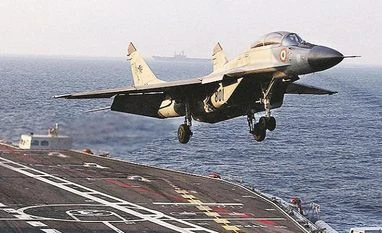The Indian Navy’s second indigenous aircraft carrier, INS Vishal, will not be – as has been widely reported – an American-style, nuclear-powered “flat-top”. Instead, it will be a conventionally powered 65,000-70,000 tonne vessel, housing some 55 aircraft and incorporating a state-of-the-art “electro-magnetic aircraft launch system” (EMALS) to catapult aircraft off the carrier.
This is the configuration being cleared through the defence ministry; Business Standard has learned through off-the-record interviews with five officials directly connected with the INS Vishal project.
The INS Vishal proposal is before the Services Capital Acquisition Categorisation Higher Committee, headed by the Chief of Integrated Defence Staff. Before the year-end, it could be cleared by the ministry’s apex Defence Acquisition Council, chaired by the defence minister. Given its stratospheric cost, it will also require clearance from the Cabinet Committee on Security.
The navy, which was eager to incorporate nuclear propulsion for INS Vishal, has been told by the Bhabha Atomic Research Centre (BARC) that it would take 15-20 years to develop a nuclear reactor powerful enough for an aircraft carrier, incorporating features to protect it from the corrosive and dynamic marine environment.
BARC has successfully developed a 190 Megawatt (Mw) reactor for India’s fleet of four-to-six nuclear propelled, nuclear missile carrying submarines, of which the first — INS Arihant — has already been commissioned. However, INS Vishal would require a reactor capable of generating at least 500-550 Mw. That means developing a brand new, miniaturised reactor, ruggedised against a marine environment.
Nor is such a 550-Mw reactor in the development pipeline, because of a dispute over who will pay the bill. Says an indignant navy admiral: “BARC wants us to place a ‘developmental contract’ to fund the reactor’s development. Why should we do that?”
Contacted by email for comments, BARC did not respond.
Instead of nuclear reactors, an Integrated Electric Propulsion System (IEPS) will now drive INS Vishal. This will be based on gas turbines that drive generators to produce electricity. The electricity will rotate powerful electrical motors that will turn the warship’s propellers, driving it through the water.
In a nuclear powered warship, the reactor produces steam to drive the electrical generators that produce electricity. That drives the motors and, in turn, the propellers.
The challenge in designing a ship-borne nuclear reactor includes protecting it from saline corrosion, shock, impact and developing the radiation shielding needed to protect the crew – which would spend longer periods of time, in closer proximity to the reactors, than in land-based nuclear power generation plants. In addition, are the issues around refuelling the reactor cores and storing spent fuel.
Designing an IEPS-driven vessel involves different challenges, including identifying a compatible combination of gas turbines, generators and motors, says a designer involved in INS Vishal. Industry sources say India’s choice of conventional propulsion opens the doors for British and French shipyards to provide design assistance. Both are both building conventionally powered aircraft carriers, while the US has built only nuclear powered reactors for decades.
Crucially, Indian Navy designers have concluded that an EMALS can be powered through gas turbine driven generators. The navy wants INS Vishal to have a catapult launch facility, which allows the launch of heavier and more diverse aircraft than the ski-jump launch fitted on Indian carriers – the in-service INS Vikramaditya and the under-construction INS Vikrant. Instead of six-decade-old steam catapult technology, the navy has decided to equip INS Vishal with EMALS, which America has fitted for the first time on its newest aircraft carrier, USS Gerald R Ford.
EMALS features what its maker, General Atomics, calls a “dial-up-a-power-level”, allowing catapult power to be adjusted to launch aircraft of completely different sizes – from a light drone to a 60-tonne P-3C Orion maritime surveillance and anti-submarine aircraft. EMALS can launch many more aircraft per hour and is easier to maintain. Steam catapults are more subject to corrosion and put far greater stress on the aircraft being launched.
Unlock 30+ premium stories daily hand-picked by our editors, across devices on browser and app.
Pick your 5 favourite companies, get a daily email with all news updates on them.
Full access to our intuitive epaper - clip, save, share articles from any device; newspaper archives from 2006.
Preferential invites to Business Standard events.
Curated newsletters on markets, personal finance, policy & politics, start-ups, technology, and more.
)